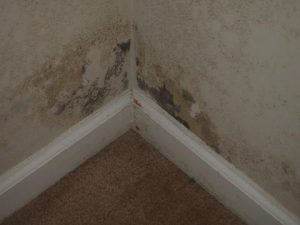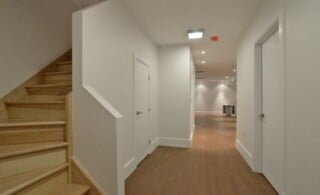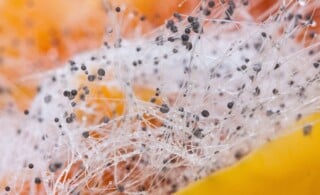 Mildew is a thin, black, or sometimes white, growth produced by mold. Though molds are always present in the air, those that cause mildew need moisture and certain temperatures to grow. Mold will grow on anything, and mildew will flourish wherever it is damp, humid, warm, poorly lit and/or where air is not circulated. Cellars, basements, crawl spaces, and even clothing closets should be watched closely for growth.
Mildew is a thin, black, or sometimes white, growth produced by mold. Though molds are always present in the air, those that cause mildew need moisture and certain temperatures to grow. Mold will grow on anything, and mildew will flourish wherever it is damp, humid, warm, poorly lit and/or where air is not circulated. Cellars, basements, crawl spaces, and even clothing closets should be watched closely for growth.
Mildew can also be found on draperies and rugs in basement recreation rooms, on shower curtains, and on damp clothes rolled up for ironing. These molds are also likely to grow in a new house because of moisture in the building materials. As the molds grow, they cause considerable damage and leave a musty odor. They discolor fabrics (including leather) and sometimes they eat into them until the fabrics rot and fall to pieces. To protect your home and your possessions, mildew prevention is a must!
Moisture & Humidity Prevention Basics
House mold cannot exist without a source of moisture; mildew prevention is basically a process of seeking out areas that are too moist or humid and drying them up. Excessive moisture or humidity may indicate that repairs or additional insulation are needed. Some basements are continually wet from water leaking through crevices in the wall, so replace cracked or defective mortar and make sure outside drainage is adequate. If your clothes dryer is equipped with a vent, have it exhausted to the outside to remove moist air. Get rid of dampness throughout the house by heating for a short time, then open the doors and windows to let out the moisture-laden air. An exhaust fan may also be very beneficial in mildew prevention.
Ready to start your Mold or Mildew Removal?
Find ProsCool air holds less moisture than warm air. Properly installed air-conditioning systems remove moisture from the air by taking up warm air, cooling it, and circulating the cool, dry air back into the room. A humidistat can be attached to the unit to control the humidity. When using air-conditioners or dehumidifiers, keep windows and doors closed.
Air movement and good ventilation are excellent at removing moisture. When the air outside is drier than that inside, ventilation allows the dry air to enter, take up excess moisture, and then get carried outside. When natural breezes are not sufficient, you can use electric fans placed in a window, set in a wall, or vented to the attic to move air from the house.
Never let clothing or other fabric articles lie around damp or wet. Dry soiled clothes before putting them into the hamper. Stretch out wet shower curtains. Dry washed garments and fabrics thoroughly and quickly. Fabrics dried slowly may get sour and musty smelling; this is not a good sign.
Mildew Prevention: Take Proper Precautions
If you already have house mold problems, mildew prevention is a tedious task. However, by identifying places where house mold is likely to form, you can nip the problem in the bud by keeping these areas clean and dry. Environments that contain warm temperatures and high humidity levels are ideal for mildew growth. Soil on dirty articles, including clothing, can supply enough food for mildew to start growing when moisture and temperature are right. Greasy films, such as those that form on kitchen walls, also contain many nutrients for mildew-causing molds. Make sure that these areas are watched closely, and make it a point to keep them as clean as possible.
Preventing Musty Mildew Odor
Musty odors, which indicate mold growth, are sometimes noticeable in basements and shower stalls. Take special precautions to get rid of musty odors as soon as possible to prevent further objectionable and damaging house mold. Usually musty odors disappear if the area is well heated and dried. If the odors remain, a service professional is your best bet.
 Lead Paint Common Sense
Lead Paint Common Sense  How Do I Get Rid of the Moldy Odor in My Basement?
How Do I Get Rid of the Moldy Odor in My Basement?  Understanding Toxic Black Mold
Understanding Toxic Black Mold  Guide to Room-by-Room Repairs for Easy Accessibility for Disabled Loved Ones
Guide to Room-by-Room Repairs for Easy Accessibility for Disabled Loved Ones  Pool Safety Guide for Homeowners
Pool Safety Guide for Homeowners 

I have a 100+ year stone house- recently during wet weather my hall way walls are showing patches of what looks like damp. these appear in the centre of the wall ,and the paint work is not peeling,so I do not think its damp within the walls- when the weather improves and we have sunshine-warm weather these patches seem ti disappear . would you please advise
regards
I have a car port under my back deck but the deck allows rain to pass between the boards. The carport is “protected” from due concrete walls that are about 7 feet high. Consequently the carport is usually very damp. If I put a “ceiling” below the deck in the carport I am afraid the dampness may rot the deck. What do you suggest ? My goal is to do the work myself….. Thanks
Thanks for sharing these article. I also check every part of our house if there are mildew developing. I these to ensure and maintain the cleanliness of our house for my families safety from diseases.
Ventilation is key to preventing mold. Never had a mold problem in a dry room.
We live in Preston, Maryland in a natural farmstone house built during 1960. The stone was milled from quarries in Pennsylvania and natural shale. Through the years we are experiencing increased condensation problems and in review to encapsulate the crawspace and install a permanent dehumidifier. We have replaced windows twice and in cold months condensation on the widows develops mostly on the north side of the house which has ruined window frames and sills. 8 years ago we added upper dormers and reinsulated the attic area around them. Again, in cold months condensation drips down the wallboard around the dormer attic area which is well insulated. Unfortunately the original owners built the house without any insulation in the outer walls, just in the attic area. We think there could be moisture now developing between the stone with cracking mortar and settling through the years. We are in the quote stage to do a remodel in the bathroom/bedroom area (North side of house) and considering pulling the wallboard to insulate at that time. Limited mildew has developed on the North side of the house, and occasionally clothing feels damp, etc. In review of various posts this appears to be a common problem with stone houses aging with mortar cracks and natural moisture from the stone absorbing water.
My primary concern, if we insulate the walls which lessens the air space between the stone and wallboard will this create another problem.
Our home is gorgeous and one-of-a kind in this area, we are making all attempts to preserve the home but after 40 years of living here it is becoming a challenge. We welcome any and all recommendations for eliminating the condensation problems.
Thank you..
I have a tenant who lives in a studio apt. downstairs and in the year that he has lived there he has never once opened a window and the blinds are always closed so no sun or air get into the apt. for ventilation. He is complaining that the air in the apt. is damp/wet and there is some mildew. How do I get rid of the moisture in the apt.?
When the man took the sample, he pressed several times on one tape. Does that affect the spore count?
We live in SW Louisiana very hot and humid. It had been in med to high 90s with 95% humidity, husband is leaving his office window open about 4 to 6 in 24 hrs a day
I told him he is going to grow mold. He says I am wrong. I went in early this morning and tile was damp to touch and swampy smelling and air felt damp. I think I am right. Will that cause mold growth? Thank you
It is impossible to get rid of all mold and mold spores indoors; some mold spores will be found floating through the air and in house dust. The mold spores will not grow if moisture is not present. Indoor mold growth can and should be prevented or controlled by controlling moisture indoors. If there is mold growth in your home, you must clean up the mold and fix the water problem. If you clean up the mold, but don’t fix the water problem, then, most likely, the mold problem will come back.